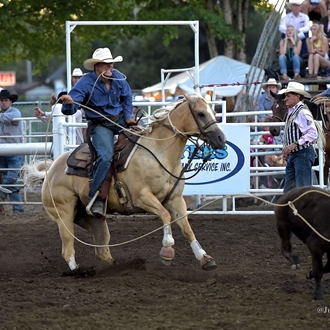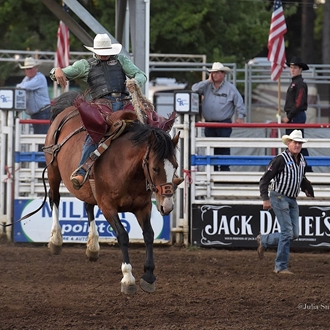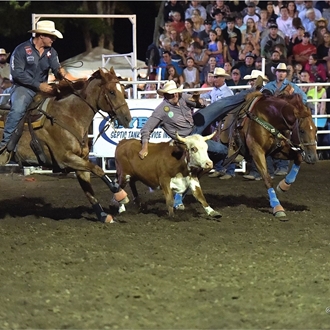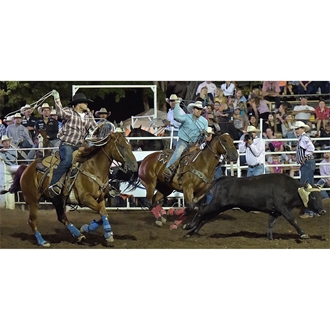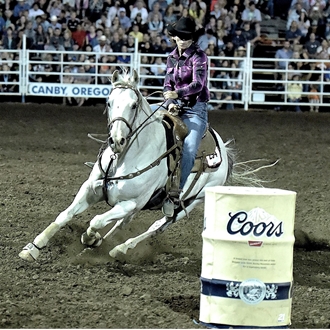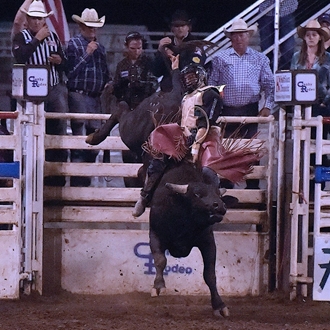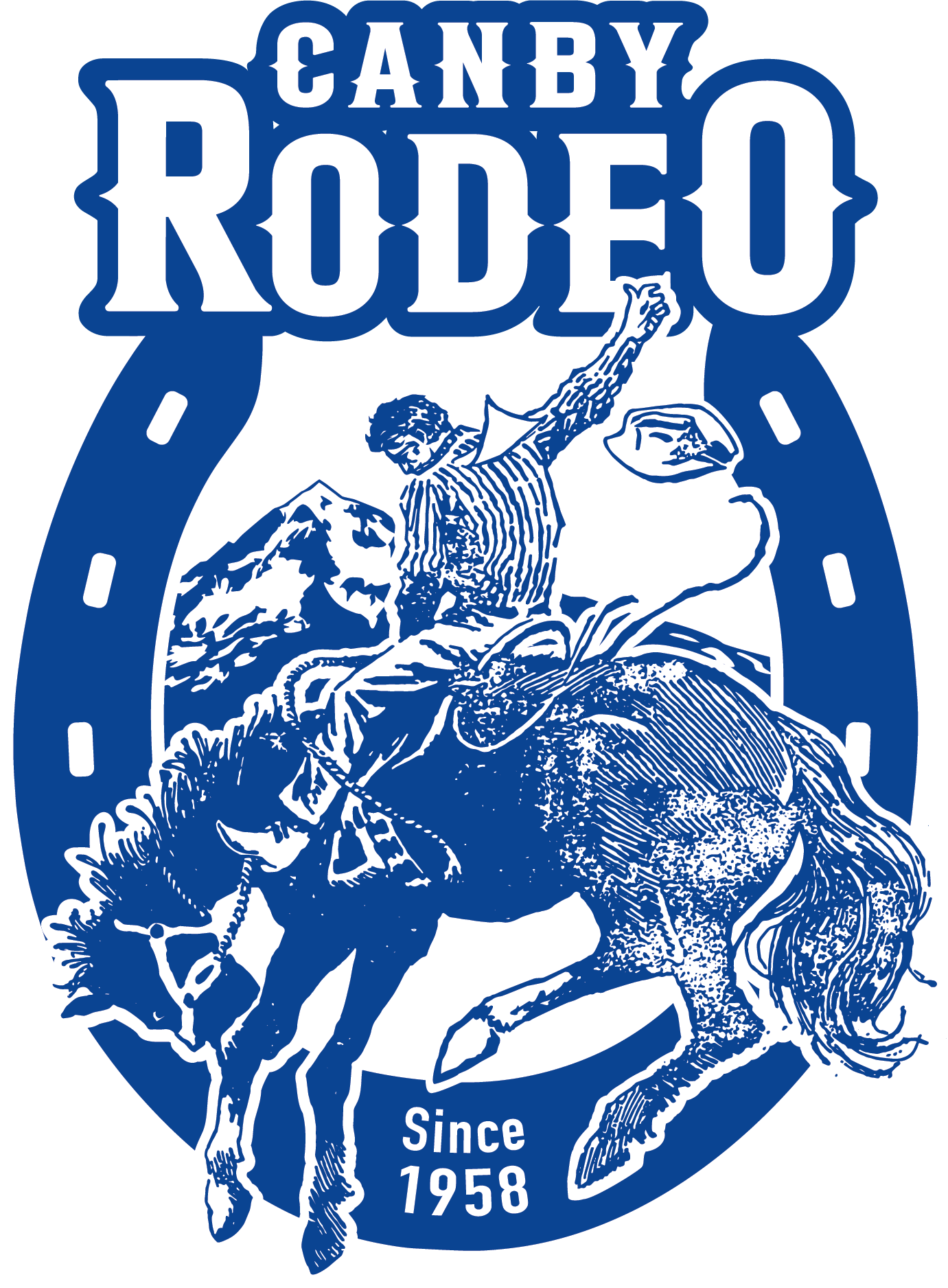RODEO EVENT DESCRIPTIONS
The bareback bronc rider does not use a saddle or rein, but uses one hand to grip a simple handle on a surcingle style rigging placed on the horse, just at the horse’s withers. The rider leans back against the bucking horse and spurs in an up and down motion with his legs, in rhythm with the motion of the horse.
Originally based on the necessary horse breaking skills of a working cowboy. The event is now a highly stylized competition that utilizes horses that often are specifically bred for strength, agility, and bucking ability.
On the first jump out of the chute, the rider must “mark the horse out”. This means he must have the heels of his boots in contact with the horse above the point of the shoulders before the horse’s front legs hit the ground. The rider that manages to complete a ride is scored on a scale of 0-50 and the horse is also scored on a scale of 0-50. Scores in the 80s are very good, and in the 90s, are exceptional. A horse who bucks in a spectacular and effective manner will score more points than a horse who bucks in a straight line with no significant changes of direction.
The rider must lasso the calf from horseback by throwing a loop of the lariat around the calf’s neck. Once the rope is around the calf’s neck, the roper signals the horse to stop quickly while he dismounts and runs to the calf. The calf must be stopped by the rope, but cannot be thrown to the ground by the rope. If the calf falls, the roper loses seconds because he must allow the calf to get back on its feet. When the roper reaches the calf, he picks it up and flips it onto its side. Once the calf is on the ground, the roper ties three of the calf’s legs together with a short rope known as a “piggin’ string”. A half-hitch knot is used, sometimes referred to colloquially as “two wraps and a hooey” or a “wrap and a slap”. The piggin’ string is often carried between the roper’s teeth until he uses it. The horse is trained to assist the roper by slowly backing away from the calf to maintain a steady tension on the rope.
Timing is critical. From a standstill, a rider will put his horse into a gallop from the box shortly after the calf leaves the chute, so that the horse saves valuable seconds by being at near-full speed the moment the barrier releases. However, if the rider mistimes his cue to the horse and the horse breaks the barrier before it releases, a 10 second penalty will be added to hit time. This is sometimes referred to as a “Cowboy Speeding Ticket”.
When the tie is complete, the roper throws his hands in the air to signal “time” and stop the clock. The roper then returns to his horse, mounts, and moves the horse forward to relax the tension on the rope. The timer waits for six seconds, during which the calf must stay tied before an official time is recorded. Top professional calf ropers will rope and tie a calf in 7 seconds. The world record is just over 6 seconds.
In saddle bronc the rider uses a specialized saddle with free swinging stirrups and no horn. The saddle bronc rider grips a simple rein braided from cotton or polyester and attached to a leather halter worn by the horse. The rider lifts on the rein and attempts to find a rhythm with the animal by spurring forwards and backwards with his feet. The rider must “mark out” (position the spurs over the horse’s shoulders) until after the first jump to give the horse the advantage. The rider’s spurs have no sharp edges, and the more the contestant spurs the horse, the higher the score. During the ride you’ll see the top pro riders keep their chins down and focus on the horse’s shoulders. This is how they determine which direction the horse will turn and helps with timing their spurring.
Disqualification occurs if the rider loses the stirrup or rein, is touched by the free hand or touches the horse or any part of the equipment with the free hand, or is bucked off before the whistle blows. The rider is scored by judges for skill and technique, and the horse is scored for difficulty. The two judges each mark the horse on a twenty-five point scale where an animal that changes direction, twists, and kicks powerfully will obtain a higher score than one which simply gallops around the arena. With horse performance accounting for as much as half of the total score, cowboys want to be assigned (draw) horses that regularly score in the 20-25 point range. The two scores are combined, and the rider with the highest total wins. Scores in the 80’s are very good.
This event is also known as Bulldogging. When the steer wrestler is ready, he calls for the steer and the chute man trips a lever, opening the doors. The suddenly freed steer breaks off and simultaneously releases the barrier for the steer wrestler. The steer wrestler attempts to catch up to the running steer, lean over the side of the horse which is running flat out, and grab the horns of the running steer. The steer wrestler then is pulled off his horse by the slowing steer and plants his heels into the dirt further slowing the steer and himself. He then takes one hand off the horns, reaches down and grabs the nose of the steer, pulling the steer off balance and ultimately throwing the steer to the ground. Once all four legs are off the ground, an official waves a flag marking the official end and a time is taken. The steer is released and trots off. Typical professional times will be in the range of 3.5 to 10 seconds from the gates opening to the waving of the flag.
Team Roping is a two-person team that competes to catch a steer for time. The first roper is referred to as the “header” (the person who ropes the front of the steer, usually around the horns), and the second roper is the “heeler”, who ropes the steer by its hind feet. Team roping is the only rodeo event where men and women compete equally together in professionally sanctioned competition.
When the header is ready, he or she calls for the steer and an assistant pulls or trips a lever, opening the chute doors. The freed steer breaks out running. When the steer reaches the end of the rope, the barrier releases. The header must rope the steer with one of three legal catches: clean horn catch (around both horns), a neck catch (around the neck), or a half-head catch (around the neck and one horn). The header then takes a “dally”, which is a couple of wraps of the rope around the horn of the saddle. Speed is important and some have lost fingers in this event. Once the header has made the dally he will turn his horse, usually to the left, and the steer will follow, still running.
The heeler waits until the header has turned the steer. When he or she has a clear way, he throws a loop or rope under the running steer’s hind legs and catches them. As soon as the heeler also dallies tight, the header turns his horse to directly face the steer, immobilizing the animal. As soon as the steer is stretched out, an official waves a flag and the time is taken. The steer is released and trots off. There is a 5 second penalty for roping only one hind leg, and 10 second penalty for breaking the barrier.
A successful professional-level team takes between 4 and 12 seconds to stretch the steer, depending on the length of the arena. At lower levels, a team may take longer, particularly if the heeler misses the first throw and has to try again.
A horse and rider attempt to complete a pattern around pre-set barrels in the fastest time. Though both girls and boys compete at the youth level, and men compete in some amateur venues, in collegiate and professional ranks, it is primarily a rodeo event for women. It combines the horse’s athletic ability and the horsemanship skills of a rider in order to safely and successfully maneuver a horse through a clover leaf pattern around three barrels. These are typically three fifty-five gallon metal or plastic drums placed in a triangle in the center of an arena.
In timed rodeo events, the purpose is to make a run as fast as possible, while the time is being closed either by an electronic eye (a device using a laser system to record times), or by an arena attendant or judge who manually takes the time using a keen eye and a flag to let a locker know when to hit the timer stop; though this last method is more commonly seen in local and non-professional events.
The timer begins when horse and rider cross the start line, and ends when the barrel pattern has been successfully executed and horse and rider cross the finish line. The rider’s time depends on several factors, most commonly the horse’s physical and mental condition, the rider’s horsemanship abilities, and the type of ground or footing (the quality, depth, content, etc of the sand or dirt in the arena).
If a horse and rider should knock a barrel down, a five second penalty per barrel will be added to the rider’s time. If all three barrels are knocked down, fifteen seconds are added to the rider’s time. Bumping the barrels is a common occurrence, but penalties will only be added if the barrel actually falls over and hits the ground. If a rider should go off course (not completing the pattern correctly), the rider will be disqualified and a score of “no-time” will be given.
Riders enter at the red line, circle around the 1st barrel to the right, proceed to the 2nd barrel and circle it to the left, and then continue to the 3rd where they will complete the pattern with a circle to the left and finally exit the course crossing the red line a second time. This pattern is often referred to as a “Cloverleaf”. The pattern may also begin with the left barrel first, but the turns will be a turn to the left followed by two turns to the right (A Diagram of a Barrel Racing Course to the right).
A rider mounts a bull and grips a flat braided rope. After he secures a good grip on the rope, the rider nods to signal he is ready. The bucking chute is opened and the rider must attempt to stay on the bull for at least eight seconds, while only touching the bull with his riding hand. His other hand must remain free for the duration of the ride. The bull bucks, rears, kicks, spins, and twists in an effort to throw the rider off. This continues for a number of seconds until the rider is bucked off or dismounts after completing his ride. To receive a score, a rider must stay on the bull for 8 seconds, which is announced by a loud buzzer.
Throughout the ride, bullfighters, also popularly known as rodeo clowns, stay near the bull in order to aid the rider if necessary. When the ride ends, either intentionally or not, the bullfighters distract the bull to protect the rider from harm.
Many competitions have a format that involves multiple rounds, sometimes called “Go-rounds”. Generally, events span two to three nights. The rider is given a chance to ride one bull per night. The total points scored by the end of the event are recorded, and after the first or first two go-rounds, the top 20 riders are given a chance to ride one more bull. This final round is called the “Short go”. After the end of the short go, the rider with the most total points wins the event.
The ride is scored from 0-100 points. Both the rider and the bull are awarded points. There are usually two judges, with each judge scoring the bull from 0-50 points, and the rider from 0-50 points. The combined point totals from both judges make up the final score for the ride. Scores of zero are quite common as a lot of riders lose control of the animal almost immediately after the bull rages out of the bucking chute. Many experienced professionals are able to gain scores of 75 or more. A score above 80 is considered excellent, and a score in the 90’s is exceptional.


